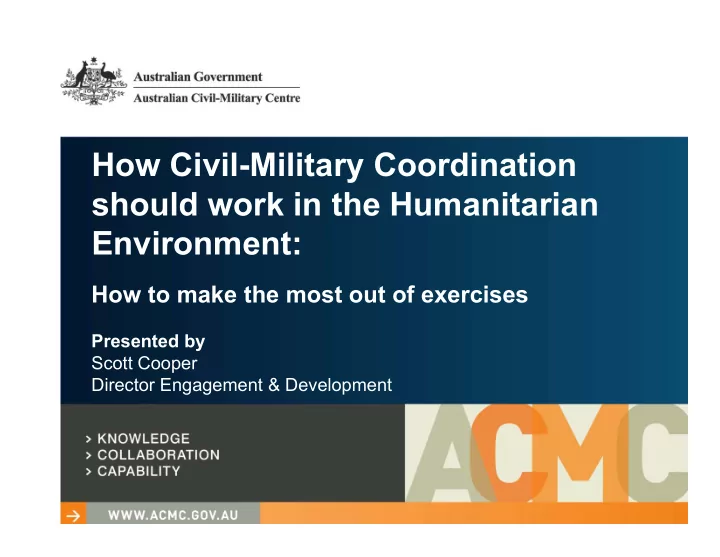

How Civil-Military Coordination should work in the Humanitarian Environment: How to make the most out of exercises Presented by Scott Cooper Director Engagement & Development
Objectives • Outline background of Australian Civil-Military Centre • Identify the ‘new reality’ of Civil-Military interaction • Explore some existing perceptions • Examine how far we can go towards harmonisation • Discuss some principles for harmonisation • Commit to what we each can do 2
What does the ACMC do ? support development of civil-military-police capabilities to prepare for, and respond more effectively to conflicts and disasters overseas. 3
Aceh 2004 Tsunami Pakistan 2005 Earthquake 2010 Floods New Zealand 2011 Australia’s Earthquake Philippines Recent 2013 Typhoon Experience in Vanuatu 2015 HADR Cyclone 4
‘New reality’ = many actors, more tasks • Host State • Intergovernmental (ASEAN) • United Nations (e.g. OCHA) • Military (National, Regional) • Police (Local, National, Regional) • Government Departments • ICRC • NGOs (e.g. Oxfam, World Vision, CARE) • Private Sector 5
Complexity In an increasingly globalized world, none of the critical issues we are dealing with can be resolved within a solely national framework. All of them require cooperation, partnership and burden-sharing among Governments, the United Nations, Regional organizations, non-governmental organizations, the private sector and civil society Kofi Annan UN Secretary-General 6 UN Annual Report , 2001
Some perceptions: How non-military agencies often view military… POSITIVE NEGATIVE Military bring needed logistics Issues become militarised Military provide heavy lift/people Military lack expertise in sustainable HADR Military fill urgent gaps Military tend not to have a sustainable exit/transition option Military provide needed security Military HADR blurs boundaries, adds risk Military help coordinate Military footprint dominates operations Military understand Aid is not core Concerns about Aid in a military business face/uniform 7
Not only the military plan ‘Everybody plans, we just do it differently’ Military Civilian • Centralised, hierarchical • Flexible and dynamic Planning • Fact and assumption based • Responsive to ‘on the ground need’ • Highly structured (JMAP) • Situation specific detailed • Contingency plan in advance planning • Clear delineation of levels. • Combines levels, roles and processes. Environment Control the environment Respond to the environment End state ‘return to normal’ ‘build back better’ 8
ACMC Civil ‐ Military ‐ Police Interaction Model COEXIST COMMUNICATE COORDINATE COOPERATE COLLABORATE Occupy same Liaise and share Direct Liaison Officers Secondments space updates communication Co ‐ locate, co ‐ Deconflict via Attend each Hold joint Ongoing joint chair, joint interlocutor other’s meetings meetings working groups working groups Share assets, Interoperable Co ‐ plan work resources, systems and and exercises training language Agree on shared Ownership of outcomes shared outcomes Co ‐ funding, MoU arrangements ACMC Model for more effective civil ‐ military ‐ police interaction during disaster response
My terminology : Integrated = whole-of-government = Unity of Purpose Comprehensive = whole-of-response = Unity of Understanding Operational success depends on integrated and comprehensive approaches 10
For government partners operational success depends on an Integrated approach Success in humanitarian and disaster management results from the ability of civilian, military and police personnel to • plan collaboratively , • resource appropriately , and • respond quickly through an integrated approach
The Integrated Approach 12
For non-government partners operational success depends on a Comprehensive approach • Share information, • Deconflict, • Understand boundaries & limitations, and • Build awareness and understanding through a comprehensive approach
‘Principles’ for Harmonisation • Employ collaborative and flexible approach • Share as much as you can as soon as you can • Strengthen proactive multiagency engagement • Promote shared understanding • Commit to continuous improvement – Lessons Learnt 14
How to make the most out of Exercises • Before Exercise (‘New Reality’ is complex) • Every participant knows who all the other actors are • Exercise Planning & Conduct (Everybody plans, in own way) • Involve all actors in initial planning (continue involvement) • Make the exercise serials comprehensive and ‘real’ • Post Exercise (Commit to improvement) • Lesson Learnt (multiagency and multinational coordination) 15
Summary: What can I do? Same Space Different Mandates • Recognise others share same space, Seek out more information but have different mandates, cultures, Try not to revert to your last deployment responsibilities, objectives, processes. Get your facts about other organisations and their priorities • Understand different roles and Simplify my language – your goal is to responsibilities. be understood • Keep lines of communication open. Identify common program areas Meet with other organisations • Develop relationships, build trust. Take advantage of existing coordination structures • Build capability before crisis through Be proactive in sharing information multiagency training, exercises, networking, professional reading, Commit and deliver secondments, workshops. Read up and stay informed 16 ‘Same Space, Different Mandates’, ACMC/ACFID 2012
Some ideas to think about . . . • Success in disaster response operations requires concurrent lines of planning and effort • Transparency between actors so that they can coordinate – need to know, becomes need to share! • In recent years cooperation has been forged at the operational level, but by then it is often too late • We need to invest in relationship development and awareness before deployments (and exercises)
Questions? Scott Cooper Director Engagement & Development www.acmc.gov.au Level 2, 34 Lowe Street QUEANBEYAN, NSW Australia 18
Recommend
More recommend